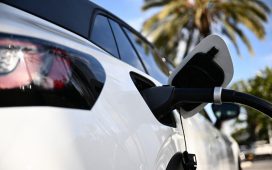Fuel consumption increases when vehicles stop and start at traffic signals. Transmitting traffic signal data to connected vehicles could control vehicles’ driving speed and limit unnecessary stopping and starting, potentially lowering fossil fuel use. A recent study looked at the benefits and costs of deploying more signal messaging technology to inform future infrastructure investments.
MnDOT’s Connected Corridor project, which concluded in 2020, laid the groundwork for connected vehicles (CVs) by developing and deploying technology for vehicle-to-infrastructure communications. Signal phasing and timing (SPaT) data identifies the current status and upcoming changes of traffic light phases at signalized intersections. The data is then broadcast to CVs through dedicated short-range communications (DSRC) receivers.
Most new vehicles are equipped with adaptive cruise control aimed at helping drivers maintain a safe following distance. If those vehicles were also connected and could communicate with infrastructure, SPaT broadcasts could control the driving speed of CVs to correspond with upcoming traffic signals. This action could minimize stopping, starting and acceleration, and potentially reduce fuel use.
“It’s helpful to have this cost–benefit assessment before we invest in more SPaT infrastructure. Once connected vehicles are driving these corridors, we could see sizable reductions in fuel consumption,” said Daniel Rowe, ITS project manager, MnDOT Office of Connected and Automated Vehicles.
Because SPaT systems can be costly, MnDOT was interested in understanding the positive impact on fuel consumption when these technologies are combined in diverse traffic scenarios at different CV market penetrations.
What Was Our Goal?
The goal of this project was to explore the fuel efficiencies of SPaT broadcasts interacting with CVs to control speed along connected corridors. The findings from this investigation could then be used to inform possible future SPaT deployments.
What Did We Do?
Four vehicles with DSRC receivers were outfitted with existing communications and signal timing tools to record SPaT and other data describing the geometric layout of the lanes traversing an intersection. GPS tracking devices recorded vehicle trajectories, including speed and acceleration profiles. Data collection covered various traffic scenarios, including peak and off-peak hours and vehicle maneuvers relative to other vehicles.

The collected data contributed to the development of a traffic flow prediction model and speed control method that could predict the upcoming traffic based on the SPaT data. The methodology could then calculate the vehicle’s optimal speed to minimize fuel consumption based on varying levels of CV market penetration along the corridor. The CVs were again driven along the corridor to test and refine the model and speed control method.
Laboratory testing evaluated the fuel savings from CVs driving the connected corridor. In the lab, an engine simulated a traditional vehicle traveling at a fixed distance from the preceding vehicle, a connected and autonomous vehicle (CAV) driven by the proposed co-optimization technique and a traditional vehicle controlled by an intelligent driver model.
Using the sampled traffic data, the traffic prediction and speed optimization method was refined and used to develop a holistic simulation methodology. The framework was then used to predict the benefits in fuel consumption for vehicle platoons with CAV market penetration rates from 10% to 90%.
Lastly, traffic assignment modeling enabled estimates of the fuel saving benefits of deploying SPaT in three additional corridors based on a comparison of installation, operation and maintenance costs. Cost–benefit ratios were generated for different CV market penetration rates.
What Did We Learn?
Testing the traffic flow prediction model and speed optimization method in the connected corridor using realistic traffic flow samples yielded an approximately 12% fuel savings for a CAV. Similarly, using the traffic flow prediction model and speed control method in the lab, the CV driven with the co-optimization method achieved a benefit of over 11% compared to the base vehicle.
“This research demonstrates that using SPaT messages with connected and automated vehicles is a feasible way to decrease fuel consumption, both economically and technologically,” said Michael Levin, assistant professor, University of Minnesota Department of Civil, Environmental and Geo-Engineering.
The simulation methodology using the refined traffic prediction model and speed optimization method showed that fuel savings increased as CAV market penetration rates increased. While the costs of deploying SPaT units at intersections will vary depending on the existing signal hardware at the intersections, researchers estimated a 10-year total cost of approximately $300,000 for 17 intersections.
Adding three prospective SPaT locations with a 10% CV market penetration yielded a fuel savings benefit ranging from 1.7 to over 4.5 times the cost per corridor.
What’s Next?
This research positioned MnDOT to provide infrastructure to accommodate CVs once there are meaningful market penetrations. By accessing SPaT data, vehicles with automated speed control can improve their fuel efficiency as can the traditional vehicles following them.











